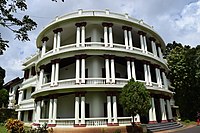Kingdom of Cochin
King Unni Goda Varma warmly welcomed Pedro Álvares Cabral on 24 December 1500 and negotiated a treaty of alliance between Portugal and the Cochin kingdom, directed against the Zamorin of Calicut.The surviving manuscripts, such as Keralolpathi, Keralamahatmyam, and Perumpadapu Grandavari, are collections of myths and legends that are less than reliable as conventional historical sources.[4] Maritime contacts Sangam period Tamilakam Cheras Spice trade Ays Ezhil Malai Confluence of religionsMamankam festival Calicut Venad - Kingdom of QuilonValluvanad Kolattunadu CochinArakkal kingdom Minor principalities Age of Discovery Portuguese period Dutch period Rise of Travancore Mysorean invasion British PeriodBattle of TirurangadiMalabar DistrictNorth MalabarSouth Malabar Battle of Quilon Communism in KeralaLakshadweep Economy Architecture The original headquarters of the kingdom was at Perumpadappu near Ponnani in present-day Malappuram district.[5] The Perumpadappu dynasty eventually produced five branches (Mutts, Elaya, Pallurutti, Madattumkil and Chaliyur), each with its own family seat, retainers and military of Nairs.[5] The Perumpadappu (and future Cochin) royal dynasty followed matriarchal rules of succession common in Kerala (similar to Travancore).The overlooked true elder was compensated with symbolic or ceremonial dignities (notably the religiously significant title Muppustanam).The Zamorin of Calicut exploited these family quarrels, sometimes in the role of arbitrator, allowing him to increase his influence in the southern kingdom.Violent floods and overflows of the Periyar River in 1341 forced the opening of the outlet between the Vembanad lagoon and the Arabian Sea at the juncture where Cochin now sits, separating the long Cochinese peninsula (karapuram) from what is now Vypin island.The once-great old port city of Kodungallur (Cranganore) declined as the new port-city of Kochi (Cochin) rose in wealth and importance.The original owners of the territory of what later became Cochin city was the Ellangallur royal family of the Rajas of Edapalli (Repelim) (on the east side of the lagoon).It was originally not supposed to be a permanent cession, but rather to serve as a training ground, to allow the heir to cultivate his governing skills.So the original "kingdom of Cochin" (Kochi rajyam) started off as a small Edapalli offshoot, distinct and separate from the much larger Perumpadappu state.The Zamorin's armies were eventually successful and imposed a settlement, which confined the king of Cochin to his domains, and extracted an oath of vassalage to Calicut.The king of Cochin, Unni Goda Varda (referred to as "Trimumpara Raja" in Portuguese chronicles) was grating at the settlement.[15][16] He perceived an alliance with Portuguese arms as way to overthrow the Zamorin's power, recover Cochin's independence and impose his ascendancy over his relatives.The Portuguese arrived at Kappad, Kozhikode in 1498 during the Age of Discovery, thus opening a direct sea route from Europe to India.This enraged the Zamorin, the ruler of Calicut, and he attacked Cochin after the departure of Vasco da Gama and destroyed the Portuguese factory.However, the arrival of a small reinforcement Portuguese fleet and, some days later of Duarte Pacheco Pereira and the oncoming monsoons alarmed the Zamorin.And for a long a time, right after Goa, Cochin situated in the center of East Indies, was the best place Portugal had in India.Cochin hosted the grave of Vasco da Gama, the Portuguese viceroy, who was buried at St. Francis Church until his remains were returned to Portugal in 1539.After taking Calicut in a bloody battle, Ali, with a large amount of money, marched south-east towards Coimbatore through Palghat.The king brought a harbour engineer Robert Bristow to Cochin in 1920, with the help of Lord Willingdon, then Governor of Madras.Moreover, in the year 1341 a flood created an island, Puthuvippu (Vypin), and Cochin became a noted natural harbour for the Indian Ocean trade.The kingdom of Cochin was among the first Indian nations to sign a formal treaty with a European power, negotiating trade terms with Pedro Álvares Cabral in 1500.Other powerful lords around these areas were Cheranellore Karthavu who was the head of the Anchi Kaimals, Muriyanatt (Mukundapuram-Nadavarambu) Nambiar who was the head of Arunattil Prabhus, Kodassery Kartha Mappranam Prabhu-Vellose Nair, Changaramponnath Kartha, Chengazhi Nambiar (Chengazhinad Naduvazhi), and Edappali Nampiyathiri.KP Padmanabha Menon in his History of Kerala, Vol 2 mentions the Anji Kaimals whose Chief was the Cheranellur Kartha as owning all of Eranakulam.The Kaimals of Nandietter Nadu had Nayar troops of 43,000 according to Heer Van Reede of the Dutch East India Company from 1694.[39] Maharaja Rama Varma (popularly known as Madrassil Theepetta Thampuran), who reigned from 1914 to 1932, was assisted by a particularly able consort named Parukutty Nethyar Amma.Parukutty Nethyar Amma was awarded the Kaiser-i-Hind Medal by King George V in 1919 for public work and came to be known as Lady Rama Varma of Cochin.









CochinchinaĐàng TrongVijayanagara EmpireKingdom of MysorePrincely StateBritish EmpirePerumpadappuPonnaniKodungallurThripunithuraThrissurMattancherryMalayalamHinduismChristianityJudaismAbsolute monarchyRama Varma XVIIIC. P. Karunakara MenonChera DynastyTravancore-CochinKochi (Cochin)Kerala stateDominion of IndiaKodungallur (Cranganore)Zamorin of CalicutPortuguese armadasvassalsZamorinsEdapalliPedro Álvares CabralPortuguese East IndiesFort ManuelPortugueseLuso-Dutch WarDutch East India CompanyBritish East India CompanyAnglo-Dutch WarBritish paramountcykingdom of TravancoretaluksVilavancodeKalkulamThovalaiAgastheeswaramSengottaiMadras StateMalabar DistrictLaccadiveMinicoyKasaragodSouth CanaraKeralaStates Reorganisation Act, 1956Government of IndiaLater CherasMiddle AgesMahodayapuram CherasEdappallyThrissur districtAlathurChitturPalakkad districtFort KochiKanayannurKarukuttyAngamalyKaladyChowwaraKanjoorSreemoolanagaramMalayattoorManjapraKunnathunadParavur TalukChendamangalamErnakulam districtKeralolpathiKaliyugaCheraman PerumalKanyakumariGokarnaKarnatakaCommon EraWilliam LoganHistory of KeralaMegalithic cultureMaritime contactsSangam periodTamilakamCherasSpice tradeEzhil MalaiConfluence of religionsMamankam festivalCalicutVenad - Kingdom of QuilonValluvanadKolattunaduArakkal kingdomMinor principalitiesPortuguese periodDutch periodRise of TravancoreMysorean invasionBritish PeriodBattle of TirurangadiNorth MalabarSouth MalabarBattle of QuilonCommunism in KeralaLakshadweepUnification of KeralaGeographyArchitectureMalappuram districtTirunavayaPorlathiriZamorinEranadAanamalaPurakkadTravancorePeriyar RiverVembanad lagoonArabian Sea
